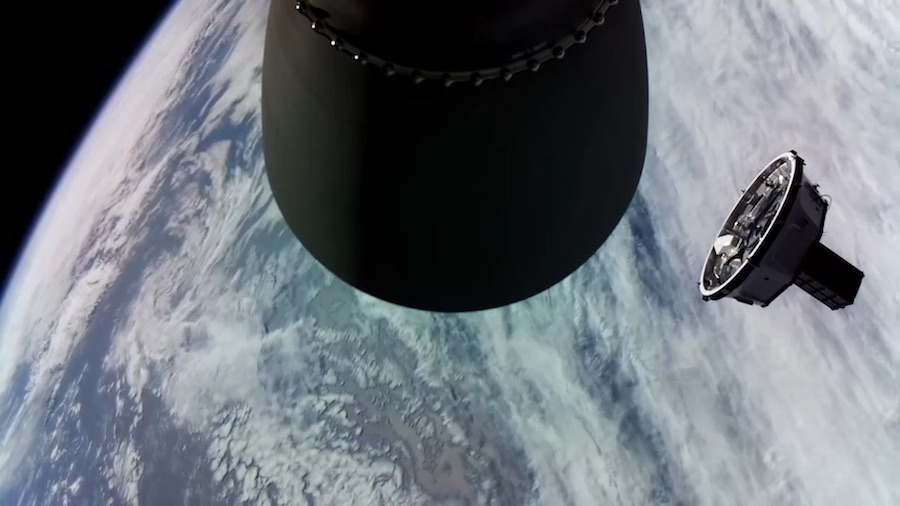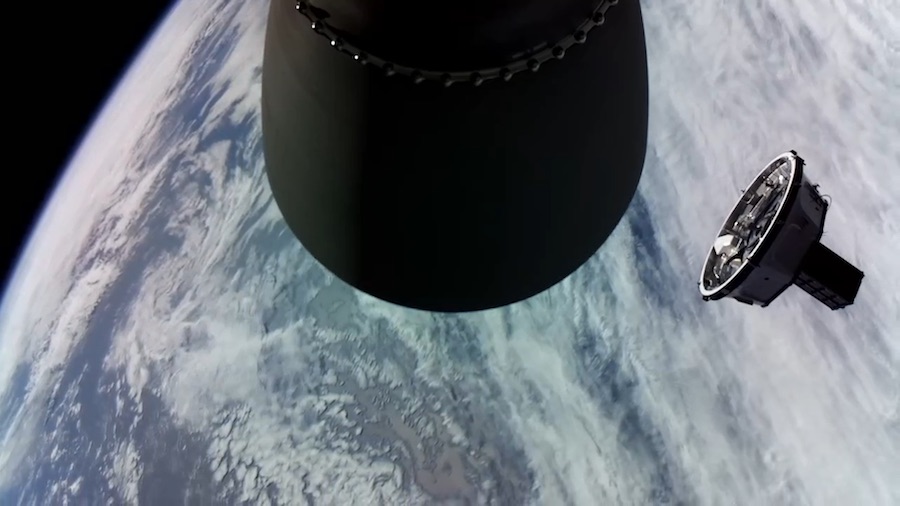
Why Rocket Lab’s Electron Kick Stage Is So Important
When launching a payload there are practically endless options and destinations where you can deliver it. Each has different difficulties and benefits when compared to the other. This is why it is very valuable and desirable when a launch provider can deliver payloads to unique orbits and destinations. Rocket Lab knows this and has worked over the past few years with Electron to expand the small-lift launch vehicle’s capabilities.
Rocket Lab’s Electron launch vehicle has access to a kick stage which significantly increases the rocket’s launch options. Specifically, the Electron Kick Stage is a streamlined path to orbit that eliminates the added risk, complexity, and cost of many other launch options and providers. This is why it is so important to not only Electron but Rocket Lab’s offer to different customers.
Small-lift launch vehicles have the massive benefit of often giving customers the option of purchasing an entire launch for themselves. This provides greater control over different important factors. However, these smaller rockets are often limited by their power and can be helped significantly by a kick stage for example. Here I will go more in-depth into this additional rocket stage and its importance for Electron and Rocket Lab.
Kick Stage Features

Rocket Lab’s Electron kick stage, also referred to as Rocket Lab’s space tug, is meant to provide unmatched flexibility for orbital deployment. The Kick Stage is designed to deliver small satellites to precise and unique orbits, whether flying as dedicated or rideshare on Electron. Some of the unique features it offers includes deorbiting, trajectory changes, higher altitude deployment, unique inclinations, sustained low altitude orbits, and more. The Kick Stage is intended to be a streamlined path to orbit that eliminates the added risk, complexity, and cost of having to develop your own spacecraft propulsion or using a third-party space tug to deliver your spacecraft to the desired orbit when flying as a rideshare.
Taking a closer look first at the design, it features a unique propulsion system. Specifically, the Kick Stage’s propulsion system consists of Rocket Lab’s in-house designed and built Curie engine, six low minimum impulse bit cold gas Reaction Control System thrusters, tank pressurization system, and high propellant mass fraction tanks which can be scaled to meet mission-specific needs. Curie is an additively manufactured, pressure-fed engine with flight heritage across more than a dozen orbital missions. It is a storable, re-startable, bi-propellant liquid propellant engine integrated with lightweight composite propellant tanks and valves into a single compact module. Curie enables on-orbit maneuvering and positioning, plane changes, and deorbit burns. The entire kick stage comes in at 405mm tall and 1.2 meters wide. Its mainly constructed out of a carbon composite and only weighs 88 pounds when dry. Aside from the main curie engine, it features 6 reaction control thrusters to help orient and deliver payloads accurately. Sat within the fairing the kick stage manages to barely take up any space while also providing an additional stage to deliver payloads.
While the kick stage is great at extending the options for a launch, it also has additional unique capabilities. With the launch market and launch demand continuing to grow, there are growing concerns regarding space debris. This especially is the case with smaller satellites once their mission or intended use is done. Rocket Lab is determined to be part of the solution for sustainability and the reduction of orbital debris in space. Traditional methods of deploying satellites can leave large rocket stages in orbit, contributing to the global issue of space debris. The Kick Stage has been designed with the capability to deorbit itself on an accelerated time scale, well before the 25 year deorbit guidelines stipulated by NASA. By performing a deorbit burn with the Curie engine, Rocket Lab can lower the Kick Stage’s perigee to increase aerodynamic drag on the spacecraft and cause it to deorbit within months or single digit years, as required. This one feature goes a long way when looking at the amount of Electron launches. In addition, the kick stage also features an impressive flight heritage. Rocket Lab’s Kick Stage has deployed more than 50 satellites to orbit across a dozen orbital launches. By now it’s even more as these numbers were based on data from October of 2020. As mentioned prior, the kick stage also has the ability to deploy multiple satellites flying as rideshare payloads to different orbits on the same mission. An example of this includes Rocket Lab’s 10th Electron mission, ‘Running Out of Fingers’, launched in December 2019. The Kick Stage’s Curie engine was ignited to circularize the orbit, before deploying a payload to 400 km. Curie then re-ignited to lower the altitude to 360 km, where the remaining payloads were deployed. This unique capability allows customers within the rideshare mission to gain more control than your typical rideshare launch.
Not only this but the Kick Stage has deployed many satellites to standard 500 km altitudes but is also capable of transferring payloads to much higher altitudes. During Rocket Lab’s Electron mission, ‘As The Crow Flies’, the Kick Stage successfully raised the payload’s orbit to 1,200 km, before Curie performed a final burn to lower the stage’s perigee by more than 700 km to rapidly accelerate the de-orbit process to avoid the used stage becoming orbital debris. The kick stage also functioned as a platform for hosted payloads, as demonstrated during Rocket Lab’s third mission, ‘It’s Business Time,’ which launched in November 2018. Following payload deployment of several CubeSats, a drag sail technology demonstrator remained integrated on the Kick Stage to test new materials and technologies designed to enable faster deorbiting of spacecraft once they reach end of life. One last feature I want to highlight has to do with extended missions. In its simplest form, the Kick Stage serves as in-space propulsion to deploy payloads to orbit. For missions that require extended payload support on orbit, or for missions exceeding 2,000 km to MEO, lunar, or interplanetary destinations, Rocket Lab offers the Photon spacecraft bus, a high-performance evolution of the Kick Stage. Photon is a configurable, modular spacecraft designed to accommodate a variety of payloads and instruments without significant redesign. Photon is equipped with radiation-tolerant avionics, deep space-capable communications and navigation technology, and high-performance space-storable propulsion capable of multiple restarts on orbit. With the capacity to both host an external payload and perform secondary mission objectives as a separate operational spacecraft, Photon has been designed for dedicated missions or as a rideshare option without the programmatic complexity, expanded cost, and schedule risk typically experienced when launching with a medium or heavy lift launch vehicle.
Impact On Electron

Now that we know some of the features and design behind the kick stage, we can take a closer look at what an actual launch with Electron looks like. After Electron’s second stage takes the kick stage to an elliptical orbit, the kick stage separates and begins a coast phase while carrying its small satellite payload. Once reaching apogee, the highest point in the elliptical orbit, the Curie engine ignites. From here, the Curie engine raises the perigee, the lowest point in the orbit, until the kick stage is orbiting the Earth in a circle rather than an ellipse. Once in this circular orbit, the kick stage has a special way of deploying multiple satellites. It employs a cold gas reaction control system to precisely point itself to deploy satellites, and the Curie engine can be reignited multiple times to move to a different position. This means small satellites can go to independent, yet highly precise, orbits even as part of rideshare missions where they hitch a ride along with other satellites. This method also avoids the risk of recontact between satellites on deployment, as Rocket Lab can control exactly when and where each satellite is released. Essentially, they won’t bump into each other as they are released. After all payloads are deployed, the kick stage has the ability to reorient itself and reignite the Curie engine one last time to perform a deorbit maneuver. This drastically lowers the kick stage’s orbit, enabling it to re-enter the atmosphere and burn up without a trace once its work in space is done. Even the second stage is deorbited quickly and burned up, thanks to experiencing significant drag at the lowest point of its orbit where it dips into the Earth’s atmosphere. Rocket Lab designed this system specifically to leave nothing in orbit but the satellites they launch.
Conclusion
There are almost limitless options when sending a payload into space. Small-lift launch vehicles offer greater control and better prices but can sometimes lack the power for certain payloads and orbits. Rocket Lab knows this and developed a kick stage for Electron that significantly expands the capabilities of the launch vehicle. The kick stage alone helps turn Electron into a much more impressive and appealing rocket to different customers. We will have to wait and see how it progresses and the impact it has on the space industry.
